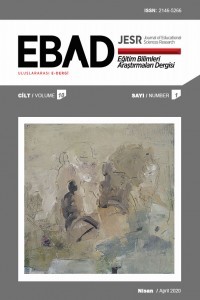PISA 2006 sınavı sonuçlarına göre Türkiye’deki öğrencilerin fen bilimleri okuryazarlığını etkileyen duyuşsal faktörler
Bu çalışmanın amacı Uluslararası Öğrenci Başarı Değerlendirme Programının (PISA) verilerine göre Türkiye’de fen okuryazarlığı ile duyuşsal faktörlerin incelenmesidir. PISA 2006 öğrenci anketinden fen bilimlerine verilen genel değer, fen bilimlerine verilen kişisel değer, fen bilimleri öğrencisi olarak kendini yeterli görme, fen bilimlerinde özgüven ve bilimsel sorulamaya verilen önem değişkenleri belirlenmiştir. Belirlenen bu değişkenlerin fen bilimleri okuryazarlığı üzerindeki etkisi cinsiyet ve okul türüne göre araştırılmıştır. Belirlenen değişkenlerin fen bilimleri okuryazarlığını kestirmeye olan katkısı Yapısal Eşitlik Modeli (YEM) ile sınanmıştır. Buna göre, öğrencilerin fen bilimleri öğrencisi olarak kendilerini yeterli görmelerinin fen bilimleri okuryazarlığı üzerinde doğrudan etkisi vardır. Kendilerini yeterli gördükçe fen bilimlerindeki performanslarında artış gözlenmektedir. Ayrıca kendilerini yeterli gördükçe bilimsel sorgulamaya önem vermekte, bilimsel sorgulamaya verilen önem arttıkça fen bilimleri okuryazarlığındaki performanslarında artış olmaktadır. Fen bilimlerine verilen genel değerin fen bilimleri okuryazarlığı performansı üzerinde doğrudan bir etkisi yoktur. Ancak bilimsel sorgulamaya verilen önemin aracı olduğu bir etkiden söz edilebilir. Öğrencilerin fen bilimlerine verdikleri genel değer arttıkça bilimsel sorgulamaya verilen önem artmaktadır. Bilimsel sorgulamaya verilen önemin artmasından dolayı fen bilimlerindeki performansta artış gözlenmektedir. Ayrıca tanımlanan bu modelin kız ve erkek öğrenci grupları ile devlet ve özel okullardan gelen öğrenci gruplarında farklılaşmadığı saptanmıştır
Anahtar Kelimeler:
PISA 2006, Fen bilimleri okuryazarlığı, Duyuşsal faktörler
The factors that affect students’ scientific literacy according to PISA 2006 in Turkey
Lifelong learning has not only been the individual’s but also society’s biggest need in the 21st century, in which rapid changes have been experienced in science, technology, and socio-economic structures. The society that consists of individuals who ‚learn to learn‛ is the society that can keep up with that era. In addition to national assessment studies they have performed in education, countries—in order to monitor at what level they have trained individuals who learn to learn—need educational indicators which present their situations among international levels. The PISA Project is one of the international studies which evaluates at what degree groups of 15-year-oldstudents have obtained knowledge and skills at the end of compulsory education so that they can be a complete member of society. The PISA assessment frame is comprised of the term ‚literacy,‛ which appertains to the capacity to have inferences from their learning in order to apply their knowledge to daily life, have logical inferences, interpret the problems in various situations and solve them (MONE, 2007). The purpose of this study is to examine science literacy and affective factors in Turkey in line with the data collected from the International Student Success Assessment Program. Among 206 student surveys, PISA has determined these variables: the general value of science, personal value of science, self-efficacy of science, self-concept of science and support for scientific enquiry. The impact of these determined variables on science literacy has been searched according to gender and school type
Keywords:
PISA 2006, Science literacy, Affective factors,
___
- Bandura, A. & Schunk, D. H. (1981). Cultivating competence, self-efficacy, and intrinsic interest through proximal self-motivation. Journal of Personality and Social Psychology, 41, 586-598.
- Betz, N. E. & Hackett, G. (2006). Career self-efficacy theory: back to the future. Journal of Career Assessment, 14, 3-11.
- Çalışkan, M. (2008). Uluslararası öğrenci başarılarını değerlendirme programı-PISA 2006’da okul ve öğrenci ile ilgili etkenlerin fen bilimleri okuryazarlık becerileri üzerinde etkisi. Yayınlanmış Doktora Lisans Tezi. ODTÜ Orta Öğretim Fen ve Matematik Alanları Eğitimi, Ankara
- Joo, Y. J., Bong, M. & Choi, H. J. (2000). Self-efficacy for self-regulated learning, academic self-efficacy, and Internet self-efficacy in Web-based instruction. Educational Technology Research and Development, 48 (2), 5–17.
- Jöreskog, K. & Sörbom, D. (2001). LISREL 8.30.Chikago: Scientific Software International Inc.
- MEB (2006). İlköğretim fen ve teknoloji dersi (6, 7 ve 8. sınıflar) öğretim programı. Ankara: MEB Yayını.
- MEB EARGED (2007). PISA 2006 Uluslararası öğrenci başarılarını değerlendirme programı ulusal ön Rapor.pdf. Erişim Tarihi: 20 Ocak 2010
- MEB EARGED (2010). PISA 2006 Uluslararası öğrenci başarılarını değerlendirme programı ulusal nihai rapor. http://pisa.meb.gov.tr/wp-content/uploads/2013/07/PISA2006-Ulusal-Nihai- Rapor.pdf. Erişim Tarihi: 20 Ocak 2010
- Miller, M. D. (2006). Scıence self-effıcacy ın tenth grade Hispanic female hıgh school students. Unpublished Master’s Thesis. MED University of South Florida
- Pajares, F. & Miller, M. D. (1995). Mathematics self-efficacy and mathematics outcomes: The need for specificity of assessment. Journal of Counseling Psychology, 42, 190-198.
- Pajares, F. (1996). Assessing self-efficacy beliefs and academic outcomes: The case for specificity and correspondence. Paper presented at the meeting of the American Educational Research Association, New York.
- Pintrich, P. R. & De Groot, E. V. (1990). Motivational and self-regulated learning component of classroom academic performance. Journal of Educational Psychology, 82 (1), 33-40.
- OECD (2006). Assessing Scientific, Reading and Mathematical Literacy: A Framework for PISA 2006. Paris: OECD.
- Schumacker, R. E. &Lomax, R. G. (1996). A beginner’s guide to structural equation modeling. New Jersey. OECD (2009) PISA 2006 Technical Report. Paris: OECD http://www.oecd.org/pisa/pisaproducts/42025182.pdf. Erişim Tarihi: 8 Ağustos 2009.
- Schruba, A. E. (2008). Evaluatıon of student attıtude toward scıence and self-efficacy in a non-majors college bıology course. Unpublished Master’s Thesis. Texas Christian University Fort Worth, Texas.
- Başlangıç: 2011
- Yayıncı: Kürşad YILMAZ
Sayıdaki Diğer Makaleler
Grafik tasarım eğitiminde görme engelliler için sosyal sorumluluk tasarımı
Milli eğitim bakanlığı sisteminin kuvvetler ayrılığından kuvvetler birliğine doğru dönüştürülmesi
Türkiye’de eğitimsel eşitsizlik ve toplumsal tabakalaşma ilişkisine dair ampirik bir çalışma
TKT 7-11 sonuçlarına göre üstün yetenekli öğrencilerin yetenek alanlarının analizi
Pedagojik formasyon programı öğrencilerinin öğretmenlik uygulaması ile ilgili görüşleri
Meslek lisesi öğretmenlerinin mesleki tükenmişlik düzeylerinin incelenmesi
Bilmecelerin eğitimdeki yeri ve önemi
M. Kürşad YANGİL, Caner KERİMOĞLU
Örgütsel adalet ve örgütsel güven algısının örgütsel bağlılık davranışına etkisi
